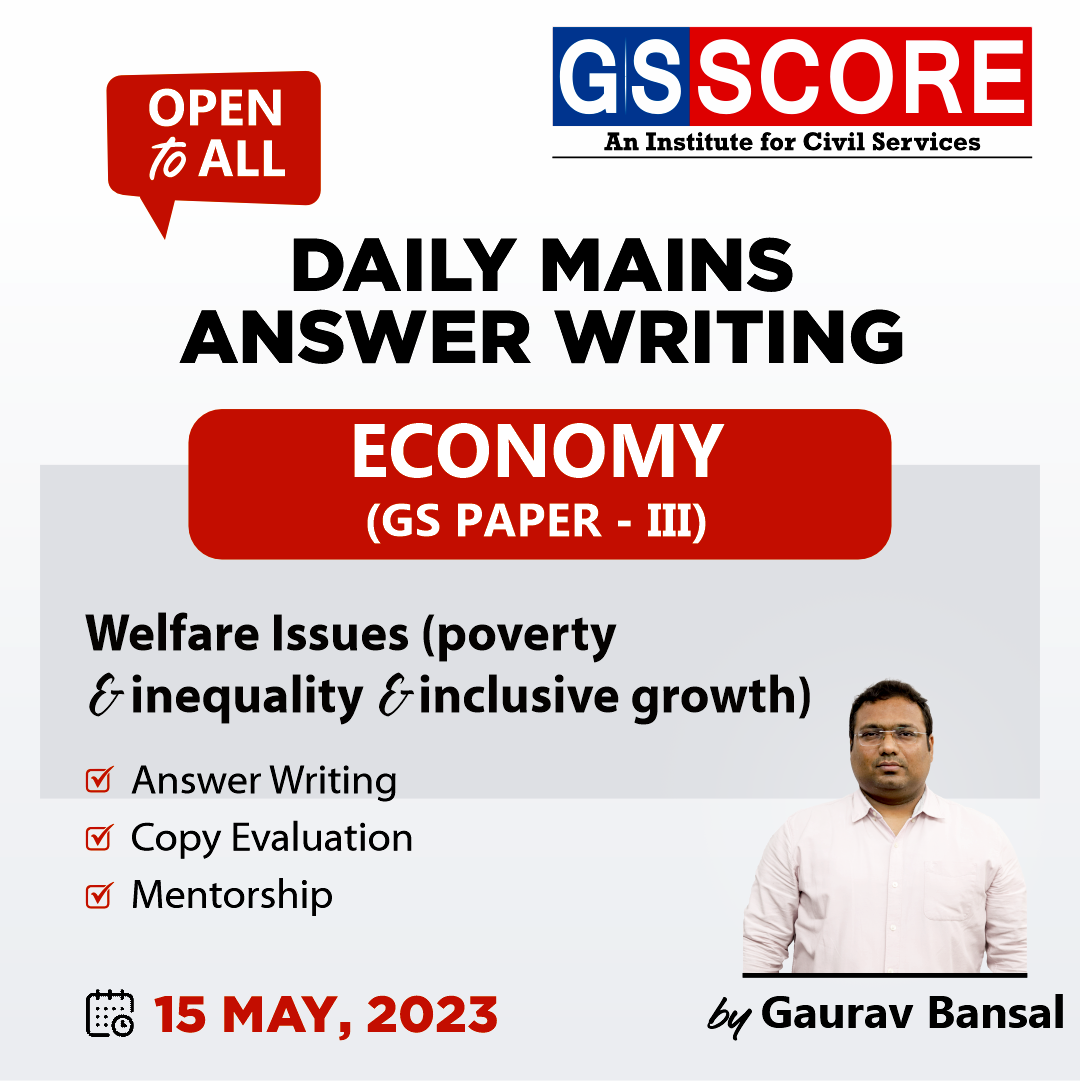


Instruction:
- There will be 2 questions carrying 10 marks each. Write your answers in 150 words
- Any page left blank in the answer-book must be crossed out clearly.
- Evaluated Copy will be re-uploaded on the same thread after 2 days of uploading the copy.
- Discussion of the question and one to one answer improvement session of evaluated copies will be conducted through Google Meet with concerned faculty. You will be informed via mail or SMS for the discussion.
Question #1. What are the main causes for rural-urban divide? What are the implications of such disparity? Discuss the policies taken by the government to bridge this gap and suggest some solutions to address it.
Question #2. Despite making efforts on the parameters of human development index, India lags a lot behind in the area. Discuss the causative factors and mention the steps required for improved performance on this platform.
(Examiner will pay special attention to the candidate's grasp of his/her material, its relevance to the subject chosen, and to his/ her ability to think constructively and to present his/her ideas concisely, logically and effectively).
STEPS & INSTRUCTIONS for uploading the answers
Step 1 - The Question for the day is provided below these instructions. It will be available at 7:00 AM.
Step 2 - Uploading of Answers : Write the answer in A4 Sheet leaving proper margins for comments and feedback and upload the PDF in MY ACCOUNT section. Click on the option of SUBMIT COPY to upload the PDF.
Step 3 - Deadline for Uploading Answers: The students shall upload their answers by 7:00 PM in the evening same day. The first 50 copies will be evaluated.
Step 4 - Feedback : Mentors will give their feedback for the answers uploaded. For more personalised feedback, join our telegram channel by clicking on the link https://t.me/mains_answer_writing_cse . A one-to-one session will be conducted with the faculty after copy evaluation in 72 Hrs.
Model Answer
Question #1. What are the main causes for rural-urban divide? What are the implications of such disparity? Discuss the policies taken by the government to bridge this gap and suggest some solutions to address it.
Approach
- The question requires the analysis of rural-urban divide
- The demand of the question is to elaborate on the implications of rural-urban disparity and suggest some solutions
- In intro define rural-urban divide with relevant data
- Then elaborate on implications of rural-urban disparity, steps taken by govt and suggest some solutions
- Conclude, by suggesting way forward
Hints:
According to the 2011 Census, India have more than 6 lakh villages while there are around 7,000 towns and urban centres. Out of a total population of 121 crores, the rural population accounts for 69% and urban population 31%.
Criteria (census-2011) for declaring an area as urban are as follows:
- Area having municipality, Municipal Corporation, cantonment board or notified area committee.
- And which satisfy these 3 conditions:
—minimum population of 5000, at least 75% of the male working population is engaged in non-agricultural activities and population density of at least 400 person/sq km
- All other areas expect urban areas are treated as rural. In general, these areas are located outside cities and most of the population is engaged in agricultural activities.
- According to UN data, India’s population in 2018 is estimated at 1.35 billion with around 67 per cent of the people still living in rural areas Rural-urban divide is clearly visible • According to Socio Economic Caste Census data reveals while poverty rates in India have generally declined, the rural poverty fell at a slower rate than the urban poverty.
Thus, about 25.7 per cent of the rural population remained below the poverty line in comparison to 13.7 of the urban below poverty line population during 2011-12
- Many in rural India also lack access to education, nutrition, health care, sanitation, land and other assets and therefore persist in poverty. The government has compiled the estimates of rural and urban per capita income in terms of Net Value Added (NVA), which is Rs 98,435 in urban areas and Rs 40,925 in the rural areas.
- The rural-urban divide is not confined to conventionally measured income. It is apparent also in education, health care and housing.
- There is also disparity in terms of infrastructure development (electricity, roads), access to services like internet etc.
- Lack of Human Resource Development – literacy (specifically female), education and skill development Implications of such disparity
- Distress urban migration: Lack of infrastructure in rural areas forces inhabitants of rural regions to seek out work in India’s mega-cities
- Slums and haphazard growth of urban regions: Delhi is the sixth-largest metropolis in the world. And yet, a third of its residences are part of slums with no basic resources.
- Cities face the adverse outcomes of rapid urbanisation such as overpopulation, acute shortage of housing and basic amenities, environment pollution, unemployment and social unrest.
- Since almost 70% of the population lives in rural areas the population will remain backward in terms of literacy, stand of living, health and skill development. This creates obstacle for reaping of demographic dividend.
Policies taken by the government to bridge this gap
- Mahatma Gandhi National Rural Employment Guarantee Act (MGNREGA) 2005: The scheme was introduced as a social measure that guarantees “the right to work”.
- Deen Dayal Antyodaya Yojana: National Rural Livelihoods Mission (DAY-NRLM): to eliminate rural poverty through the promotion of multiple livelihoods and improved access to financial services for the rural poor households across the country.
- Pradhan Mantri Gram Sadak Yojana (PMGSY): to provide connectivity, by way of an all-weather road to unconnected habitations.
- Pradhan Mantri Awas Yojana: Gramin:to help rural people below the poverty line (BPL) in construction of dwelling units and up gradation of existing unserviceable kutcha houses by providing assistance in the form of a full grant.
Government is also implementing several nutrition intervention programs like Anganwadi Services, Scheme for Adolescent Girls under the Umbrella Integrated Child Development Services Scheme to address the problem of malnutrition in the rural areas.
Suggestions
- Education of the masses by establishing evening schools for adults.
- Provisions for cheap medical aid through better PHCs and Jan-oushadi centres
- Construction of good roads and infrastructure is important to make roadways for economic growth. Promotion of the Self Help groups. Ex- Kudumbashree model can be emulated
- The Co-operative system should be promoted in Agro based Industries. Ex- South Indian sugar cooperative sector has become successful Conclusion: By addressing rural-urban divide it will ensure ease of living in villages and help minimizing migration to big cities by providing all necessary infrastructure, facilities and also resources and opportunities for livelihood in rural areas.
Question #2. Despite making efforts on the parameters of human development index, India lags a lot behind in the area. Discuss the causative factors and mention the steps required for improved performance on this platform.
Approach:
- Write about human development index and its parameters. ( 40 words)
- Write about causes for low performance.( 70 words)
- Mention the steps taken by government in this regard.( 60 words)
- Way forward. ( 50 words)
- Conclusion.( 30 words)
Hints:
Human Development Index (HDI) is an index released as part of Human Development Report published by United Nations (UN). In its recent report of 2019, India stood at 129 out of 189 countries. It is used to rank the countries on basis of development levels based on 3 parameters:-
- Education level
- Life Expectancy at birth
- Per Capita Income
Despite its multiple efforts to improve on the aforementioned parameters, India lags behind its BRICS and South Asian counterparts. Its low ranking in the index can be attributed to multiple factors:
- Lack of Political will in policy formulation and implementation with major focus on harnessing vote bank rather than upliftment of marginalized citizenry.
- India’s spending on healthcare is very less (around 1.5% of GDP) compared to other nations thus it shares a huge burden of NCDs & other diseases. Out of pocket expenditure, lack of awareness, focus on curative rather than preventive, low insurance penetration etc. lead to poor score in life expectancy.
- Higher rates of discrimination in society against girl child, disabled & other marginalized sections in school enrollment. People opt for informal employments earlier in the life due to poverty thus resulting lower rates of education.
- Huge population is a burden on India. Though Economic reforms, the policies of distributive justice of government have resulted in increase in Per capita income, the increase is insignificant. Unemployment, lack of infrastructure, skills, rising NPAs etc. catch the growth leading to reduction in per capita income.
Steps taken by government:
- Education sector: Sarva Shiksha Abhiyaan, Midday Meal, Right to Education Act, Beti Bachao Beti Padhao, Rashtriya Madhyamik Shiksha Abhiyaan, Rashtriya Ucchtar Shiksha Abhiyaan.
- Health sector: Ayushmaan Bharat, Rashtiya Bal Swasthya Karyakram, Mission Indra dhanush, ICDS, Matrititva Suraksha Abhiyaan, MAA for promoting breastfeeding.
- For improving per capita income: initiatives for promoting investments in India, Skill India program, Schemes like MGNREGA, RURBAN Mission.
What else could be done?
- Taking examples from initiatives of other nations e.g. erstwhile Healthcare program of USA referred to as Obamacare for better healthcare initiatives of citizens.
- Greater involvement of private sector in social sector spending along with active participation of civil society for upliftment of marginalized e.g. Initiatives of NGO Prayas among poor people.
- Higher level of spending on health and education sector for better outcomes.
- Increased political will displaying the true nature of democracy.
- Feedback mechanism for evaluating policy and its implementation.
Conclusion:
India’s rising global footprint on multiple platforms like economy and political participation make it imperative for improvised role of government in working towards improving its rank in human development whose low rank shed tears on other efforts of the nation.
| 1. Budget and Fiscal policy |
| 2. Resource Mobilization |
| 3. Development and Inclusive growth |


